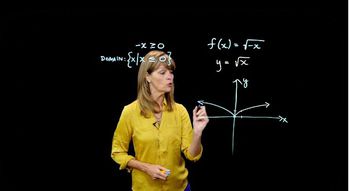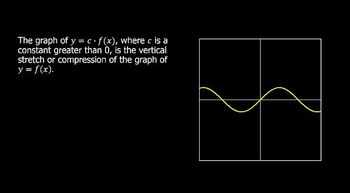Table of contents
- 0. Review of Algebra4h 16m
- 1. Equations & Inequalities3h 18m
- 2. Graphs of Equations43m
- 3. Functions2h 17m
- 4. Polynomial Functions1h 44m
- 5. Rational Functions1h 23m
- 6. Exponential & Logarithmic Functions2h 28m
- 7. Systems of Equations & Matrices4h 6m
- 8. Conic Sections2h 23m
- 9. Sequences, Series, & Induction1h 19m
- 10. Combinatorics & Probability1h 45m
3. Functions
Transformations
Problem 99a
Textbook Question
In Exercises 95-106, begin by graphing the standard cubic function, f(x) = x³. Then use transformations of this graph to graph the given function. h(x) = -x³
 Verified step by step guidance
Verified step by step guidance1
Start by graphing the standard cubic function \( f(x) = x^3 \). This graph is a curve that passes through the origin (0,0) and has a characteristic 'S' shape, increasing to the right and decreasing to the left.
Identify the transformation needed to graph \( h(x) = -x^3 \). Notice that \( h(x) \) is the negative of \( f(x) \), which indicates a reflection over the x-axis.
To perform the reflection, take each point \((x, y)\) on the graph of \( f(x) = x^3 \) and transform it to \((x, -y)\). This will flip the graph upside down.
Plot the transformed points to create the graph of \( h(x) = -x^3 \). The graph will still pass through the origin, but the 'S' shape will be inverted.
Verify the transformation by checking key points. For example, if \( f(1) = 1^3 = 1 \), then \( h(1) = -(1^3) = -1 \). Similarly, if \( f(-1) = (-1)^3 = -1 \), then \( h(-1) = -(-1)^3 = 1 \).
Recommended similar problem, with video answer:
 Verified Solution
Verified SolutionThis video solution was recommended by our tutors as helpful for the problem above
Video duration:
4mPlay a video:
Was this helpful?
Key Concepts
Here are the essential concepts you must grasp in order to answer the question correctly.
Cubic Functions
A cubic function is a polynomial function of degree three, typically expressed in the form f(x) = ax³ + bx² + cx + d. The standard cubic function, f(x) = x³, has a characteristic S-shaped curve that passes through the origin and extends infinitely in both directions. Understanding the basic shape and properties of cubic functions is essential for analyzing transformations.
Recommended video:

Function Composition
Graph Transformations
Graph transformations involve altering the position or shape of a graph through various operations, such as translations, reflections, stretches, and compressions. For instance, the function h(x) = -x³ represents a reflection of the standard cubic function across the x-axis. Recognizing how these transformations affect the graph is crucial for accurately sketching the new function.
Recommended video:

Intro to Transformations
Reflection Across the X-Axis
Reflection across the x-axis occurs when every point (x, y) on a graph is transformed to (x, -y). This means that the y-values of the function are inverted while the x-values remain unchanged. In the context of the function h(x) = -x³, this reflection results in a graph that is a mirror image of the standard cubic function, which is vital for understanding the relationship between the two functions.
Recommended video:

Reflections of Functions

 5:25m
5:25mWatch next
Master Intro to Transformations with a bite sized video explanation from Nick Kaneko
Start learningRelated Videos
Related Practice
























